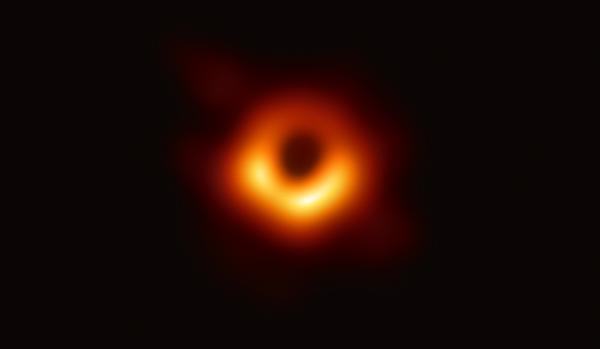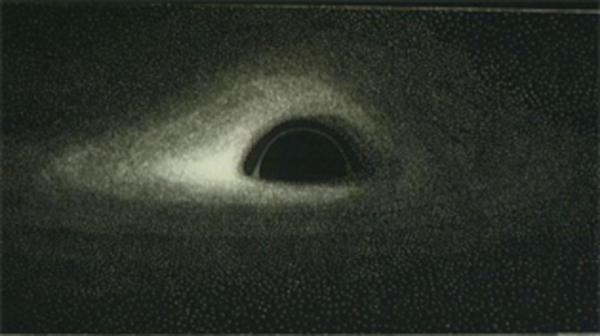
Image description: In April 2017, the information for the first image of a black hole was collected on the hard drives of various telescopes and transported by a commercial airplane to the Haystack Observatory in Massachusetts. Processed, compared, and analyzed by clusters of supercomputers, in April 2019, physicists were able to reveal this simple halo of yellow-orange light, blurry and asymmetrical, standing out against a black background. The cosmic monster, located about 50 million light-years from Earth, was imaged at the center of the M87 galaxy by an international collaboration (Event Horizon Telescope). Image source: EHT Collaboration.
Throughout history, humans have needed light to measure physical phenomena, but our vision is not very effective. What we see with our eyes is the small range of vibrations found in the electromagnetic spectrum between 380 nanometers for violet and 780 nm for red, while the image is constructed by our brain.
The wavelength of light is intimately linked to the concept of color, but there are colors we will never see, those located beyond violet and below red. They will therefore never be interpreted by our brain.
The paradox with a black hole is that it has no color by definition because light, matter, and energy are trapped within the black hole. How did the physicists of the EHT project (Event Horizon Telescope) manage to transform the information of an invisible supermassive black hole into visible light for the human eye?
A black hole retains all information. It is a mysterious object whose surface is neither solid, liquid, nor gaseous; it is a simple immaterial boundary called the "event horizon". Therefore, another way of "seeing" the invisible must be invented.
If the black hole is invisible, its environment is not, and it is thanks to it that we will be able to determine the event horizon and thus see the shadow of the black hole.
According to black hole theory, matter near the event horizon is strongly heated by accretion before being absorbed by the monster and disappearing forever into its gravitational well. But before disappearing forever, the surrounding dust and gas, as well as the residues of stars that were once broken by tidal forces, emit characteristic radiation in the millimeter wave domain (light not visible to the eye).
This radiation could reveal the surroundings of the black hole. The millimeter light rotating around the black hole will therefore provide us, by contrast, with a lot of information about the black hole (its gravitational force, how it warps spacetime, gravitational lensing effects, etc.). In summary, although invisible, a black hole "lights up" in its own way the matter it attracts.
The image above represents a black hole illuminated by the matter it has heated.
Using the technique of very long baseline interferometry, astronomers created a virtual giant telescope whose diameter is as large as the distance separating them (about 10,000 km). They combined eight radio telescopes spread across our planet (Europe, Chile, United States, Hawaii, and Antarctica).
The targets were the two most "visible" black holes from Earth. The first target was Sagittarius A* (Sgr A), the black hole located at the center of our Milky Way, 26,000 light-years away, with a mass equal to 4.1 million times that of the Sun. The other target was the supermassive black hole 1,500 times Sagittarius A* (6 billion solar masses), located 50 million light-years away at the heart of the giant elliptical galaxy M87.
The EHT teams had only a window of about two weeks each year to attempt grouped observations. To construct the high-resolution image, physicists had to subsequently combine the signals captured by the different antennas of the network with their own atomic clocks. The arrival times of the signals are accurate to one-tenth of a billionth of a second. Then they compared and calculated their point of origin to reconstruct a gigantic overall image.
A single night of observation collected 2 petabytes of data (2 x 1015). It is possible that within this mountain of data, other information is hidden that could help us better understand the very particular physics reigning in the environment close to black holes. Notably, the gigantic jets of particles and radiation that some of them project into space at speeds close to that of light.
The data hard drives stored in Antarctica then had to wait for the end of the long icy winter to be transported to the MIT Haystack Observatory and the Max Planck Institute in Bonn. This first image of a black hole that you see on your screen is composed of only 33 KB of data (33 x 103), a thousand billion times simpler than the data collected.
That is "seeing" for our brain, simplifying the complexity of reality to the extreme. A simple black silhouette surrounded by a blurry bright spot is enough for our happiness.

Image description: The first simulation (1978) by Jean-Pierre Luminet, a young researcher at the Paris-Meudon Observatory. Image source: EHT Collaboration.
In 1978, Jean Pierre Luminet (1951-), taking into account the complex distortions that the strong gravitational field imprints on spacetime and the trajectories of light rays that follow its fabric, created the first virtual image of a black hole.
In his simulation, the event horizon has the appearance of a slightly flattened disk. The gravitational field curves the paths of light rays so strongly near the black hole that the rear part of the disk is "raised". Thus, a secondary image allows us to see the other side of the accretion disk, the one located behind the black hole, which has taken the form of a thin halo of light attached to the central black disk. But the main characteristic of this simulation is the difference in brightness between the different regions of the disk.
The intrinsic brightness is maximal in the areas closest to the horizon, as this is where the gas is hottest. For a distant observer, the received light flux is amplified on the side of the image where the gas is approaching the observer.
The observer not being stationary relative to the black hole, this introduces a distortion of the images by the Doppler effect. The black hole can be animated by a rotational movement and generate an asymmetry; the black hole is no longer spherical.
Moreover, the gravitational lensing effect caused by the black hole amplifies the apparent size of its event horizon.